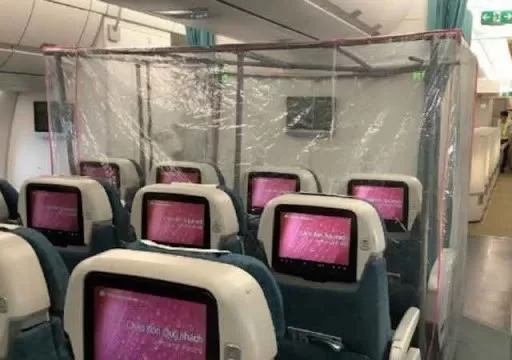When the COVID-19 pandemic broke out and became complicated, the Government directed the organization of flights to bring Vietnamese citizens from abroad back to the country to prevent and control the pandemic. From the beginning of 2020 to mid-2021, the authorities licensed and organized over 1,000 flights, bringing more than 200,000 citizens from 62 countries and territories back to the country.1
In that situation, I have consulted and summarized some reports from the Ministry of Health's Information Portal on the COVID-19 pandemic and some international articles with the aim of describing the risk of infection and sharing the response experience of experts in Vietnam.
1. Risk of COVID-19 infection on relief flights
Despite the implementation of the highest level of safety measures to prevent SARS-CoV-2 infection, there is still a high risk of infection for passengers and staff serving these flights. Author Nguyen Cong Khanh and colleagues studied the risk of infection on flight VN54 departing from London to Hanoi from March 1-16, 2020. 16 (100%) crew members and 168 (84%) passengers staying in Vietnam were traced, interviewed, and collected samples for testing; 33 (16%) passengers had transited to other countries. The study results showed that there were 15 cases positive for SARS-CoV-2 identified by PCR, including 14 cases being passengers and 01 member of the crew. By studying the chronological sequence of symptom onset, the authors demonstrated that the 15 cases were believed to have been infected by a patient (Patient 17) who had contracted the disease before boarding the flight. In addition, the study also pointed out that the likely route of transmission on the flight was via aerosols or droplets from Patient 17, especially for those in the same cabin87 with the patient.2
Current evacuation/relief flights are mostly international flights with long flight times. This not only leads to imported cases but also facilitates widespread transmission throughout the flight.3
2. Initiative to reduce the risk of COVID-19 infection by doctors at the National Hospital forTropical Diseases, Vietnam
The flight carrying 219 Vietnamese citizens from Equatorial Guinea back to Vietnam, departing on the morning of July 28, was considered “unprecedented” when 120 people, or more than half of the passengers, had previously tested positive for SARS-CoV-2. Dr. Than Manh Hung, head of the working group from the National Hospital for Tropical Diseases, who was on the flight, said that the risk of infection for the crew and medical staff participating in the flight was very high due to the narrow space of the plane while the number of positive patients was high.4
To minimize the risk of infection, doctors have planned to divide the plane into 4 areas:
- The tail of the plane is for positive patients;
- The area for patients without test results and negative patients;
- Area 3 is for medical staff
- The 4th area is for the crew.
90 passengers who tested negative for COVID-19 were seated in the upper compartment, followed by the buffer room and the back of the plane carrying 129 passengers who tested positive for COVID-19. Passengers are provided with protective gear, which they wear throughout the flight.
The most important and special initiative to reduce the risk of infection during flights, according to Dr. Hung, is the use of positive pressure chambers. This is a study by a group of doctors from the Emergency Department, Central Hospital for Tropical Diseases, and experts from the University of Technology.4
In the middle of the separated areas, doctors will place comfortable things made of nylon fabric and simple removable plastic frames. There are a total of 4 stations installed, each weighing about 7-8kg, and the installation takes 5 to 7 minutes.4
These positive pressure chambers will help reduce the risk of the virus spreading from one area to another, between positive and negative patients as well as the flight crew. In principle, when using a positive pressure chamber, air will be blown in from the outside through a filter system, which can filter out viruses. Filtered air can be considered clean air. In situations where medical staff and flight crew have high-risk operations (for example, when removing masks to eat), the positive pressure chamber will help reduce the risk of infection. "This is a very important solution when the flight time from Equatorial Guinea to Noi Bai is up to 15 hours," Dr. Hung said.4
Upon entry, all passengers, crew and medical staff were quarantined at the Central Hospital for Tropical Diseases.
Compiled by: Le Minh Dat (email: lmd@vpha.org.vn)
References
1. Nguyễn Hưởng. Con số đáng sợ ở "chuyến bay giải cứu". Báo Người Lao Động. Accessed July 30, 2024. https://nld.com.vn/phap-luat/con-so-dang-so-o-chuyen-bay-giai-cuu-20230710221738307.htm
2. N. C. Khanh, P. Q. Thai, H. L. Quach, et al. Transmission of SARS-CoV 2 During Long-Haul Flight. Emerging infectious diseases. Nov 2020;26(11):2617-2624. doi:10.3201/eid2611.203299
3. J. Zhang, F. Qin, X. Qin, et al. Transmission of SARS-CoV-2 during air travel: a descriptive and modelling study. Annals of medicine. Dec 2021;53(1):1569-1575. doi:10.1080/07853890.2021.1973084
4. CỔNG THÔNG TIN CỦA BỘ Y TẾ VỀ ĐẠI DỊCH COVID-19. 4 y bác sĩ BV Nhiệt đới TW lên đường "giải cứu" công dân Việt từ Guinea Xích đạo. Bộ Y tế. Accessed July 30, 2024. https://covid19.gov.vn/4-y-bac-si-bv-nhiet-doi-tw-len-duong-giai-cuu-cong-dan-viet-tu-guinea-xich-dao-1717072246.htm




